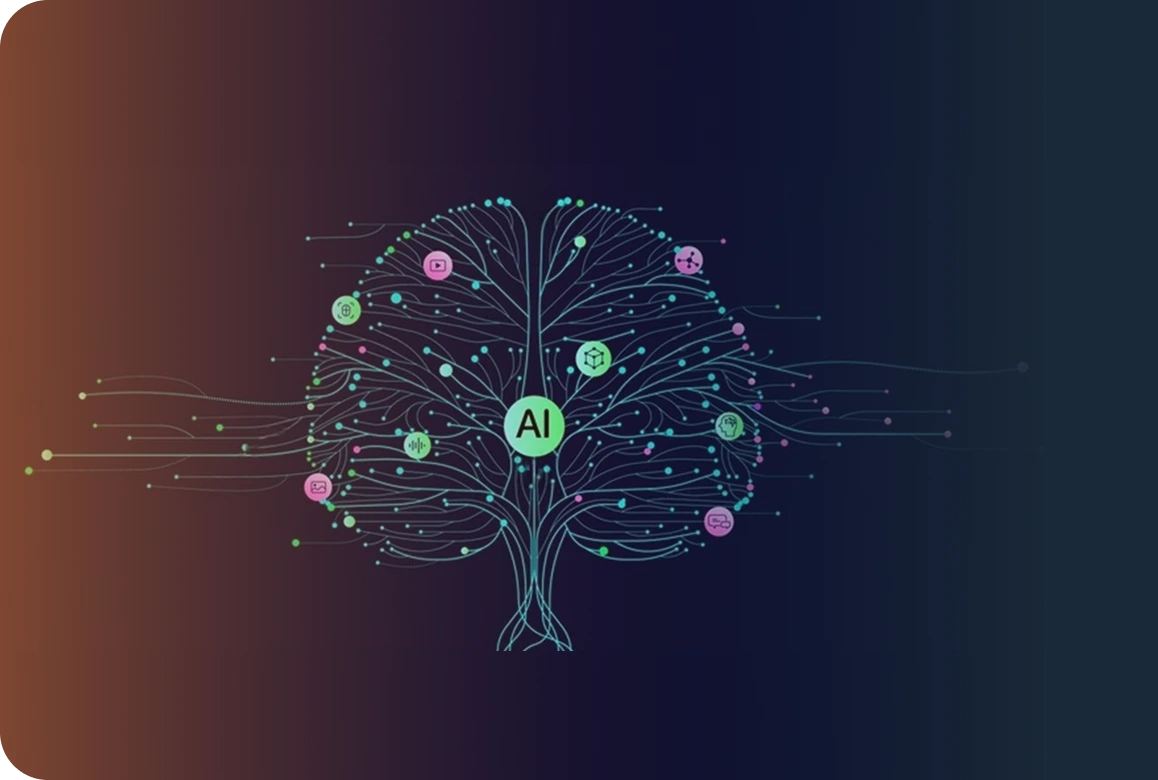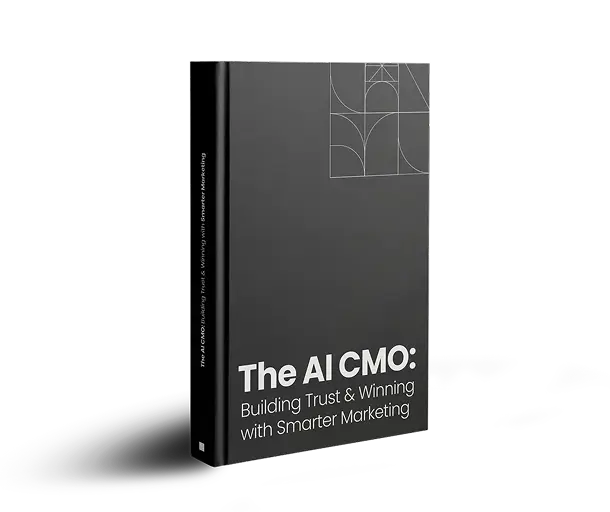
In modern B2B marketing, waiting around for in-market buyers is no longer a viable strategy. To drive consistent pipeline growth, brands must engage prospects across the entire buyer’s journey. From uncovering latent pain points that have yet to be identified, to fostering trust during the evaluation phase, and ultimately converting intent into measurable revenue.
Understanding the differences between demand creation, generation, and capture is critical. While these terms are often used interchangeably, they represent distinct yet complementary strategies: demand creation sparks new interest and awareness, demand generation nurtures and educates that interest over time, and demand capture converts active buying intent into measurable pipeline.
B2B marketers who master all three unlock a full-funnel strategy that fuels sustainable growth and accelerates go-to-market success.
Demand Generation vs Demand Capture vs Demand Creation: What B2B Marketers Need to Know
In B2B marketing, knowing the difference between demand generation vs capture vs creation isn’t just helpful, it’s essential. Most teams lean heavily on demand capture because it’s easy to measure. But if you’re only capturing existing demand, you’re competing in the noisiest part of the funnel. To grow in today’s market, you need to create and capture new demand and know exactly when to use each strategy.
Here’s how they differ and why mastering each is key to driving predictable pipeline and revenue:
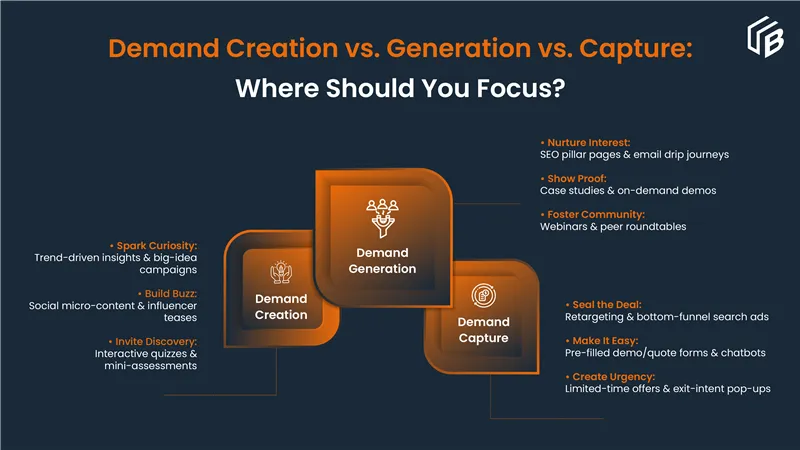
What Is Demand Creation in B2B Marketing?
Demand creation is the proactive strategy of building awareness and interest among potential buyers who are not yet in-market. It focuses on identifying latent pain points, shaping buyer perception, and positioning new problems or opportunities before the prospect begins an active search for solutions.
In B2B marketing, demand creation drives top-of-funnel activity by using thought leadership, category education, and strategic content to influence early-stage thinking and expand the total addressable market. This approach seeds a long-term pipeline by engaging stakeholders early in their decision-making journey.
Examples of demand creation marketing include:
- Develop thought leadership content that reframes industry challenges
- Category creation campaigns
- Strategic use of dark social, podcasts, and influencer voices
- Problem-first messaging, not product-first
Why it matters: You’re expanding your Total addressable market (TAM) by shaping buying criteria and creating future demand.
What is Demand Generation?
In B2B marketing, demand generation is the bridge between demand creation and demand capture. It’s about nurturing interest and moving potential buyers closer to the point of purchase.
Here’s what demand generation often looks like:
- Someone saw a thought leadership post (demand creation)
- Now they’re attending a webinar or downloading an eBook (demand generation)
- Soon, they’ll be searching for your solution (demand capture)
Capitalizing on demand generation means delivering value at every stage of the journey, from problem awareness to consideration. The best B2B demand generation strategies combine content, email nurture, and targeted campaigns to guide buyers forward.
What Demand Generation process looks like:
- Targeted email sequences and retargeting
- Educational webinars and whitepapers
- ABM programs that personalize mid-funnel content
- Product-centric storytelling that connects to buyer pain points
Why it matters: You’re warming up audiences already exposed to your brand and helping them evaluate solutions, ideally with your value proposition leading the conversation.
What is Demand Capture?
Demand capture is the process of identifying and converting in-market buyers who are actively searching for solutions. It focuses on high-intent prospects using performance marketing, SEO, paid search, and other bottom-of-funnel tactics to drive conversions.
In B2B marketing, demand capture capitalizes on existing interest and accelerates revenue generation through timely, relevant offers, optimized landing pages, and effective sales enablement tools. The objective is clear: capture and convert buyers who are already in-market and actively looking for solutions.
This highlights the importance of balancing demand generation and demand capture strategies.
What Demand Capture looks like:
- Paid search and review site optimization
- Conversion-focused landing pages
- Free trial or demo offers
- Intent data from platforms like G2, Bombora, or 6sense
Why it matters: This is the stage where revenue is generated; you’re closing the loop by converting active demand into opportunities and deals.
How is Demand Created?
Here’s how high-performing B2B teams create demand in today’s landscape:1. Leveraging Strategic Content Marketing
Content marketing is fundamental to B2B demand creation. Rather than relying on product promotion, modern B2B marketers focus on delivering insight-driven content that educates and shifts buyer perspectives. According to DemandMetric, 70% of B2B buyers prefer to consume information through articles and blogs over traditional ads. Moreover, content marketing generates three times more leads than outbound tactics, at 62% lower cost.
To maximize impact:
- Use content atomization to repurpose pillar content, such as whitepapers and eBooks, into smaller, reusable pieces that can be shared across various platforms and formats, including blogs, videos, LinkedIn posts, and email sequences.
- Leverage content syndication to distribute educational assets across high-value channels and reach audiences outside your owned media.
- Prioritize ungated, high-value content that builds trust and thought leadership.
2. Adopting a Product-Led Growth (PLG) Approach
Product-led growth is especially effective for B2B SaaS companies. It allows potential buyers to experience the value of your offering firsthand through freemium models, free trials, or interactive demos. Instead of leading with a sales pitch, PLG builds trust by letting users explore your product in a low-risk environment.
Incorporating PLG into demand creation:
- Shorten the path to value with intuitive onboarding.
- Encourage internal advocacy by demonstrating ROI through usage data.
- Pair product experience with educational content to deepen product understanding.
According to recent studies, B2B buyers increasingly value the buying experience itself as a key decision factor. Letting your product “sell itself” enhances that experience and builds momentum in the funnel.
3. Hosting Expert-Led Webinars and Virtual Events
Webinars are among the most scalable and effective tools for creating demand, especially in a post-pandemic, remote-first B2B world. Decision-makers want to learn from industry experts, analysts, and practitioners, not salespeople. Webinars allow you to frame strategic problems, offer fresh insights, and subtly introduce your solution category, without pushing a product.
Webinar success factors:
- Collaborate with third-party thought leaders to enhance credibility.
- Focus on trends, data, and actionable insights.
- Repurpose webinar content into clips, infographics, and gated replays to drive ongoing engagement.
Done right, webinar landing pages can convert at rates exceeding 51%, offering both awareness and lead generation in one format.
4. Running Managed Placement and Programmatic Advertising
While paid media is often associated with demand capture. However, managed placement advertising, particularly through programmatic platforms can also be a powerful tool for creating demand when used strategically. With greater control over audience segments, ad frequency, and contextual relevance, B2B marketers can reach their ideal customer profile earlier in the buying journey.
Best practices for managed placements:
- Use intent signals, firmographic data, and technographics to refine targeting.
- Focus ads on pain points and category-level education, not product features.
- Combine with remarketing to move audiences from awareness to engagement.
Example of Demand Creation:
A company selling AI-based forecasting software might launch a thought leadership campaign revealing how traditional sales forecasting methods are fundamentally flawed, long before they ever mention their own product.
Key KPIs to Measure Demand Creation Success:
- Increase in brand awareness
- Growth in branded search volume
- Increase in website sessions and social media reach
How B2B Brands Generate Sustainable Demand
1. Demand Creation Fuels Awareness and Interest
Demand generation starts with demand creation. It begins by educating the market, shaping buyer perspectives, and positioning your brand as a trusted authority in your category.
Key strategies include:
- Insight-driven content that reframes problems or introduces new ones
- Brand storytelling that builds trust and relevance over time
- Thought leadership across organic and paid channels
- Awareness campaigns tailored to buyer personas and industries
The objective at this stage is not conversion, but to build brand recognition, encourage consideration and to ensure brand is preferred, when the buyer enters an active purchasing cycle.
2. Demand Capture Converts In-Market Buyers
Once awareness and interest exist, whether organically or through intentional demand creation, the next phase is demand capture. This is where your team activates high-intent prospects who are already searching, evaluating, or comparing solutions. Most B2B marketers are heavily indexed here because it’s easier to measure and attribute.
Demand capture focuses on:
- Paid search and retargeting
- Conversion-optimized landing pages
- Demo requests, pricing pages, and comparison content
- Lead nurture and sales enablement workflows
But here’s the limitation: you can only capture what already exists. Without robust creation efforts feeding the top of the funnel, demand capture becomes increasingly expensive and finite.
3. Demand Generation Aligns Both for Sustainable Growth
True demand generation happens when demand creation and capture are strategically connected, creating awareness, then seamlessly converting that attention into a qualified pipeline.
This involves:
- Coordinated messaging across the full buyer journey
- Marketing and sales alignment around shared audience insights
- Multi-channel orchestration (content, product, paid, outbound)
- Continuous feedback loops from CRM, intent data, and campaign performance
ABM ultimately aligns the efforts of demand creation and demand capture, making it a demand generation strategy. It generates demand by targeting accounts with both top-of-funnel awareness and bottom-of-funnel conversion activities, resulting in a full-funnel approach.
Here are 3 actionable tips to use Account-Based Marketing (ABM) to generate demand:
- Use data and analytics to select high-value accounts. ABM Tools can help you with account selection and segmentation.
- Create tailored content that addresses specific pain points and challenges of each target account. This includes creating customized landing pages, whitepapers, and case studies.
- Use a combination of channels such as personalized emails, targeted advertising, and direct mail to reach decision-makers within target accounts. Platforms like LinkedIn’s Matched Audiences can be particularly effective for B2B ABM campaigns.
On our podcast, Real Talk and Real Results, Colby Wren, a Global Marketing Executive, Entrepreneur, and Startup Advisor, shared some best practices for ABM campaigns:
- Focus on quality over quantity (less is more)
- Create relevant, not just personalized content
- Think in terms of verticals
To learn more, tune in to the full episode here.
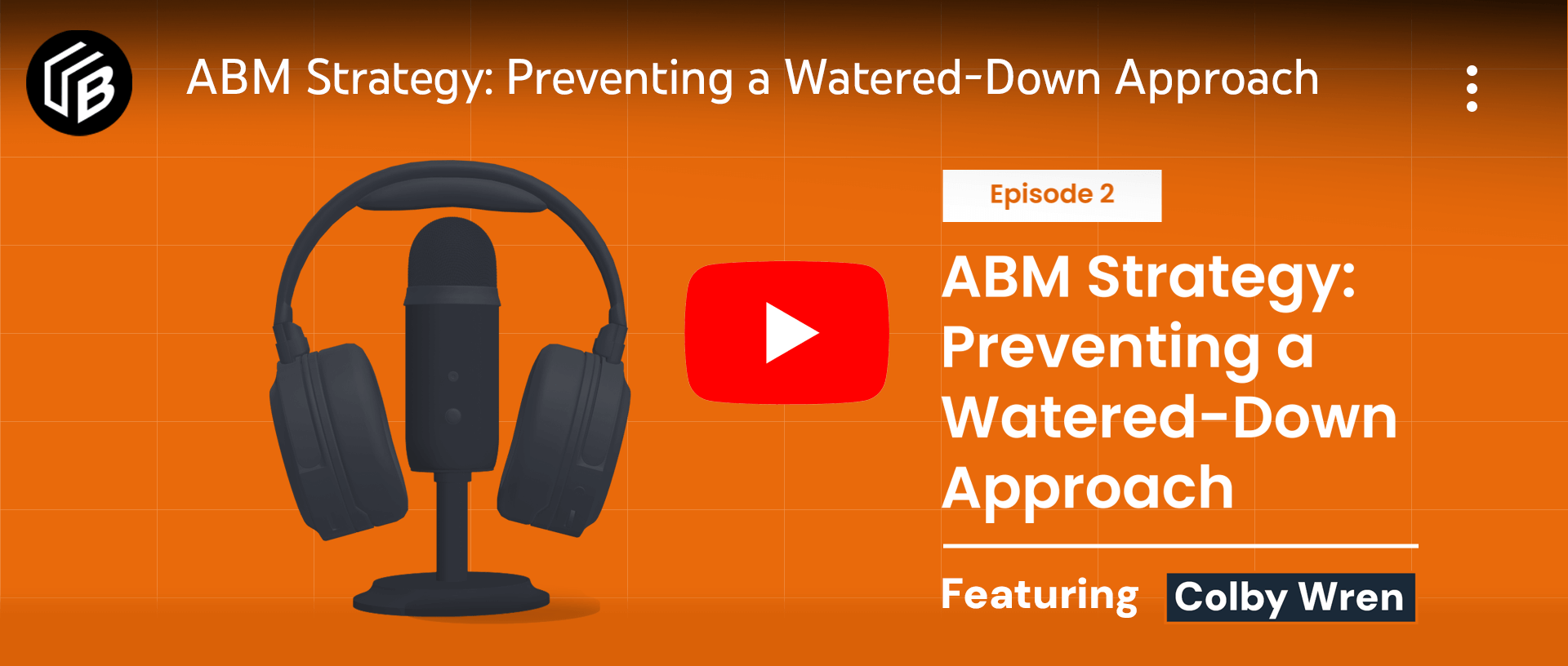
Example of Demand Generation:
The same AI forecasting company that created demand now shifts gears.
They host a webinar titled, “How Sales Teams Are Cutting Forecast Errors by 40% with Predictive Intelligence,” specifically targeting buyers who are aware of their forecasting challenges but still evaluating solutions.
Key KPIs to Measure Demand Generation Success:
- MQL (Marketing Qualified Lead) volume growth
- Engagement rates (click-through rates, open rates, content downloads)
- Movement through the funnel (from first-touch to lead conversion rate)

How to Effectively Capture Demand in the Funnel
Here’s how modern B2B marketers can optimize demand capture:
1. Streamline the Conversion Path with Multi-Step Forms
Overly long, static forms disrupt the flow of user engagement and create unnecessary friction. Multi-step forms simplify the user journey and improve the quality of captured data. When structured well, they:
- Reduce form abandonment by breaking the process into manageable steps
- Increase conversion rates without overwhelming the user
- Enable smarter segmentation through progressive data collection
Even in enterprise scenarios, studies show multi-step forms improve lead completion rates by keeping engagement high and cognitive load low.
2. Deploy Conversational Chatbots for Real-Time Qualification
AI-driven chatbots are evolving beyond basic support roles and now play a strategic part in lead capture and qualification. Today’s buyers:
- Expect fast, on-demand answers
- Prefer engaging via conversational interfaces over static forms
- Appreciate relevance and speed in their interactions
Smart chatbots can qualify prospects, route high-intent leads to sales, and collect contextual information, all while operating 24/7.
3. Introduce Gamification to Drive Deeper Engagement
Incorporating gamified elements like quizzes, interactive assessments, calculators, or mini-challenges can:
- Boost time on site and content engagement
- Reveal key buying signals through responses
- Encourage opt-ins and voluntary data sharing
Gamification works particularly well in the education or solution awareness stages, allowing prospects to self-identify their needs while enjoying the experience.
4. Use Intent Data and Behavioral Signals to Engage at the Right Moment
Precision is everything in demand capture. Leveraging behavioral analytics and third-party intent data platforms empowers your marketing and sales teams to:
- Detect when prospects are actively researching your category or competitors.
- Score leads based on real buying signals
- Trigger personalized outreach or nurture flows in real time
Combining first-party engagement data (e.g., time on site, content consumed) with third-party signals (e.g., topic-level intent) ensures you’re engaging when interest is highest and competition is low.
Example of Demand Capture:
That same AI forecasting company now shifts its focus to search ads targeting phrases like, “best AI sales forecasting software,” offering a free trial, and running retargeting ads for users who visited the pricing page but didn’t immediately convert.
Key KPIs to Measure Demand Capture Success:
- Volume of demo or trial requests
- Conversion rate from campaign landing pages
- Customer Acquisition Cost (CAC) relative to marketing investment
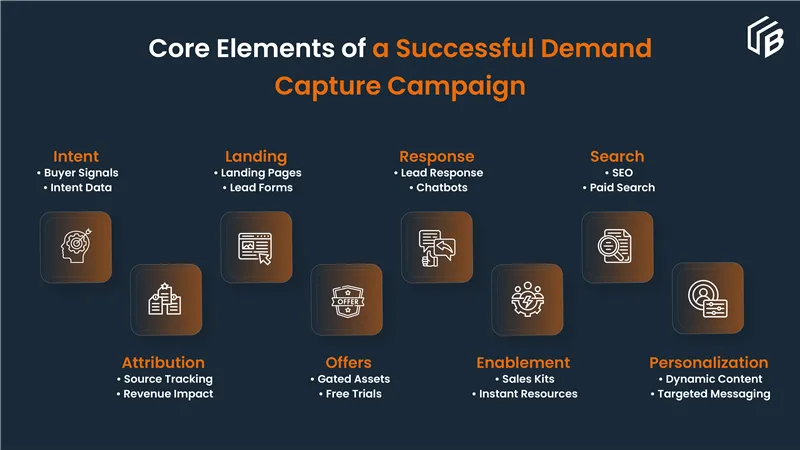
How These Three Strategies Work Together
So where does that leave us with demand generation vs capture vs creation? To succeed in competitive B2B markets, brands must integrate all three strategies:
| Strategy | Audience Awareness Level | Goal | Key Channels |
| Demand Creation | Unaware | Educate and spark curiosity | Organic social, thought leadership, events |
| Demand Generation | Problem-Aware | Nurture and educate on solutions | Email, webinars, content marketing |
| Demand Capture | Solution-Aware/Intent | Convert interest into action | Paid search, retargeting, website optimization |
The key is not to choose between demand creation and demand capture, but to align them throughout the funnel. You create new demand, nurture it through demand generation, and convert it through demand capture. This unified strategy ensures marketing efforts meet prospects where they are, improving pipeline velocity and driving sustainable revenue growth.
For more tactical insights on aligning demand strategies, check out our podcast episode Real Talk and Real Results on Optimizing Demand Creation and Demand Capture For the Buying Cycle, where we break down cross-funnel execution.
Final Thoughts: Why You Need All Three
The most effective marketing teams go beyond simply discussing demand generation, capture and creation, they build systems that support all three.
The future of B2B marketing will be defined by organizations that effectively manage the entire demand journey, not just isolated stages. Driving sustainable growth requires more than building brand awareness or fine-tuning conversion tactics in silos.
Market-leading teams create cohesive momentum from the initial point of interest through to purchase decisions, ensuring every touchpoint is strategically aligned and no qualified opportunity is lost.
Integrating demand creation, generation, and capture into a unified strategy is a business imperative. Now is the time to reassess your approach, realign your efforts, and take a leadership position in your market.
Our blog
Latest blog posts
Tool and strategies modern teams need to help their companies grow.

Interactive B2B content is reshaping the B2B sales landscape by accelerating sales en...

Not every social media platform is worth your time or budget when it comes to social ...

Many B2B marketers are increasing ad budgets but seeing little impact on pipeline or ...




